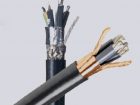
 Images courtesy EASA.
Images courtesy EASA.July 10, 2019 – End users desiring speed and/or torque control often buy variable-frequency drives (VFDs) to modify existing applications where a standard induction motor is in place. Frequently, they try to control costs by using that existing standard induction motor. Before taking that path, however, it is best to consider a few areas of concern with the approach.
Speed-torque characteristics
Motors designed for use with VFDs must meet the requirements of National Electrical Manufacturers Association (NEMA) standard MG 1, Part 31. These requirements include defined speed-torque characteristics, such as are shown in Figure 1 (see Gallery below). Additionally, motors that meet the requirements of Part 30 of the same standard may be suitable for inverter duty if appropriate measures are taken (e.g. line conditioning).
Figure 2 shows a typical speed-torque curve for an induction motor with some fixed voltage applied to the machine terminals that results in acceleration according to the machine dynamics.
Point 3 in Figure 2 represents the speed at rated or full-load torque and corresponds to Point 3 in Figure 1. Using a standard induction motor with a VFD without proper evaluation to determine Points 1, 2 and 4 from Figure 1 introduces the potential for overheating in the lower speed range (i.e. below Point 3) and mechanical damage from overspeeding (i.e. beyond Point 3).
Shaft currents
Shaft currents are another major concern. The high switching frequency associated with inverter operation produces a capacitive coupling between the rotor and the stator that can lead to shaft currents and, as a result, damage to the bearings and lubricant.
Motors designed for operation on VFDs usually have insulated bearings and shaft grounding brushes. These modifications can often be made to standard motors.
Standard induction motor stator windings are usually not insulated for use in VFD applications. Most machines designed for inverter duty use a modified magnet wire. They also may have enhanced ground insulation and more robust coil bracing.
Installation
Among other installation details to consider for VFD applications, it is important to establish a low-impedance common ground for the motor, drive and electrical system. Cable manufacturers have developed products specifically for this purpose, as shown in the photo above.
While service centres can often modify the bearing and stator winding insulation to address potential issues with VFD applications, defining a speed-torque curve to a standard motor as shown in Figure 1 is not easy. Variable-torque loads, such as fans and centrifugal pumps, are less risky candidates for such modifications, providing the maximum operating speed does not exceed the motor’s base speed. Constant-torque loads like conveyor belts would be more susceptible to overheating in the low speed range.
The most conservative approach for adding speed and/or torque control is to buy an inverter duty motor that is appropriate for the application. If the goal is just to limit starting current, using a variable-voltage, fixed-frequency soft starter is much simpler.
Mike Howell is a technical support specialist for the Electrical Apparatus Service Association (EASA), an international trade organization representing more than 1,800 firms that sell and service electromechanical apparatus offerings in approximately 80 countries. For more information, visit www.easa.com.
This article originally appeared in the June 2019 issue of Electrical Business magazine.
Print this page
